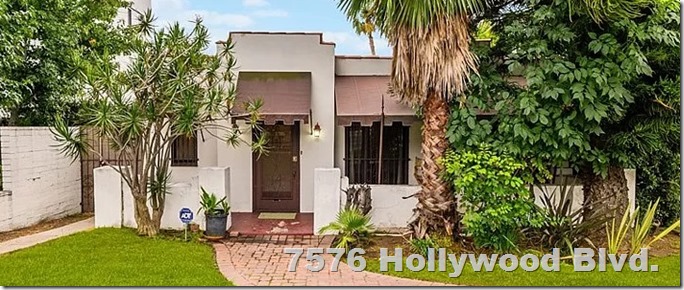
Clara Bow’s former rental at 7576 Hollywood Blvd. is on the market for $1.3 million.
Hollywood homes can show a star’s character just as much as any candid portrait. Ostentatious or understated, hip or homey, residences serve as a snapshot in time and place for their owners and society as well. Vivacious flapper Clara Bow remained a vulnerable little girl at heart, always seeking out a comfortable nest to create the safe, happy home life denied her growing up. For a short time she rented 7576 Hollywood Blvd., a small, lovely Spanish Colonial abode now up for sale and under threat.
Born into poverty and degradation July 29, 1905, Clara Bow endured hunger, misery, and abuse in a Dickensian childhood bereft of normal family pleasures. Looking for a chance of escape, she entered Brewster Publication’s Fame and Fortune Contest announced in Motion Picture magazine in January 1921. Her instinctive talent and energetic personality overwhelmed the judges, who awarded her first prize after a series of contests. Bubbly and effervescent in front of the cameras, her piercing, sensitive eyes revealed the true sadness underneath.
Clara Bow, 1925.
Over the next five years, Bow endured exploitation and abuse from all sides as she painstakingly developed her acting career, learning to relax and be herself in front of the camera. Studio executives and industry insiders took advantage of her insecurity, naivete, and need to please as she gained bigger and better parts, before she finally gained stardom after signing with Paramount in 1926 and becoming cinema’s embodiment of the flapper and the“It” girl, full of spice, naughtiness, and sensuality onscreen.
Bow frankly admitted to a magazine how much her real personality captured the dichotomy of the characters she inhabited onscreen, raucous and passionately grabbing at life. “All the time the flapper is laughin’ and dancin’, there’s a feelin’ of tragedy underneath. She’s unhappy and disillusioned, and that’s what people sense. That’s what makes her different.”
Bow’s choice of residence throughout this trying time reflected her rising career as well as her hopes for finding home. Raised in a Brooklyn tenement hovel, Bow rented apartments and small houses after arriving in Los Angeles, like most film newcomers looking to break in. She first lived in the classy but comfortable Hillview Apartments at 6533 Hollywood Blvd., owned by future Paramount boss and colleague Jesse L. Lasky, and later rented small but elegant homes that offered a sense of comfort and normalcy.
In 1924, a year or two before gaining true stardom, Bow rented 7576 Hollywood Blvd. for a few months, a three-bedroom, 2-bath Spanish Colonial on the border between Hollywood and West Hollywood. While small, the home exhibited the elegant features of its type – wrought iron, mouldings, tilework, and fine wood floors, small but classy, perfect for someone finding her place in a bustling new world.
The home’s original builder and owner was also a woman independently making a place for herself in society. Born as Mary Ines in Indiana in 1869, she married Baptist minister and eventual head of Los Angeles’ Baptist Mexican mission, Rev. L. E. Troyer, and served happily and faithfully with him bringing God’s word to others. Mary would serve as a missionary in Puerto Rico and Puebla, Mexico for a short time in in the mid-teens before returning to Los Angeles to work with Hispanic residents and immigrants as the “mother of Mexican work” per local newspapers. The couple worked in ministry and raising their family until 1917 when Rev. Troyer passed away at the age of 48.
Even before his death, Mary Troyer began participating in real estate ventures, building small properties as investment units. In 1913, she constructed a three-story apartment building on East Fourth Street. Troyer sold property in 1915 and purchased another small apartment building before constructing a bungalow court in 1919. Realizing Hollywood’s exploding growth due to the burgeoning motion picture industry, she built a duplex at 1862-1864 Vista Del Mar in 1920 before constructing a duplex at 7568 Hollywood Blvd. in 1921, living in one of the units. Troyer constructed 7576 Hollywood Blvd. in 1922 as an additional investment property, and continued her building spree through the mid-1920s, sometimes with her three sons serving as contractors under their business, the Troyer Brothers.
The simple $6,500 home at 7576 Hollywood Blvd. offered renters a chance to move up in the world and live graciously. Filled with quality touches like tile, fireplace, wood floor, and even a nice backyard, the cottage offered a cozy nest for young couples or aspiring singles. For Clara it was a step up and hope for better things as her career took off and the parts grew in size and quality. She lived here with her father and Artie Jacobsen for five months as in 1924, before moving on to the more secluded and elegant Canyon Drive home of Bessie Love, which she rented.
7576 Hollywood Blvd. is now for sale, listed as an investment opportunity in advertisements with a property on Curson Avenue behind it, a stepping stone to wealth just as Mary Troyer saw it in 1922. Sitting surrounded by apartment buildings, the lonely little cottage represents a place where Clara Bow envisioned greater opportunities and possibly a happy family life beckoning to her. What will be the home’s future?


